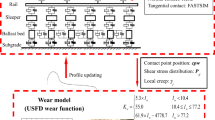Abstract
The reliable prediction of wheel wear can help to reduce maintenance costs. With the help of two common approaches (statistical, contact mechanics based), it is possible to predict wheel profile shapes either quickly and precisely, but for a unique operating situation only, or for varying operating scenarios in a more time-consuming, but often less accurate way because so many, sometimes even unknown, input data are needed. There is no method available for predicting worn wheel profile shapes quickly, accurately, and generally. The hybrid approach presented in this work combines the two state of the art approaches mentioned above in order to exploit their advantages and eliminate their disadvantages. The new method was calibrated and validated on wheel measurement data taken from the field. A good agreement between measurements and predictions was observed when using maximum wheel-rail contact shear stresses as the wear measure in the methodology.
Access this chapter
Tax calculation will be finalised at checkout
Purchases are for personal use only
Similar content being viewed by others
References
Han, P., Zhnag, W.H.: A new binary wheel wear prediction model based on statistical method and the demonstration. Wear 324–325, 90–99 (2015). https://doi.org/10.1016/j.wear.2014.11.022
Lingaitis, L.P., Mikalunas, S., Podvezko, V.: Statesticheskije imitazionije prognoznie modeli ozenok iznosa bandazhej kolesnich par lokomotivof. Transp. Telecommun. 6(3), 391–396 (2005)
Li, X., Yang, T., Zhang, J., Cao, Y., Wen, Z., Jin, X.: Rail wear on the curve of a heavy haul line—numerical simulations and comparison with field measurements. Wear 366–367, 131–138 (2016). https://doi.org/10.1016/j.wear.2016.06.024
Jendel, T.: Prediction of wheel profile wear - Comparisons with field measurements. Wear 253(1–2), 89–99 (2002). https://doi.org/10.1016/S0043-1648(02)00087-X
Ding, J., Li, F., Huang, Y., Sun, S., Zhang, L.: Application of the semi-Hertzian method to the prediction of wheel wear in heavy haul freight car. Wear 314(1–2), 104–110 (2014). https://doi.org/10.1016/j.wear.2013.11.052
Braghin, F., Lewis, R., Dwyer-Joyce, R.S., Bruni, S.: A mathematical model to predict railway wheel profile evolution due to wear. Wear 261(11–12), 1253–1264 (2006). https://doi.org/10.1016/j.wear.2006.03.025
Jun, H.K., Lee, D.H., Kim, D.S.: Calculation of minimum crack size for growth under rolling contact between wheel and rail. Wear 344–345, 46–57 (2015). https://doi.org/10.1016/j.wear.2015.10.013
Luo, R., Liu, B., Qu, S.: A fast simulation algorithm for the wheel profile wear of high-speed trains considering stochastic parameters. Wear 480–481, 203942 (2021). https://doi.org/10.1016/j.wear.2021.203942
Wang, Z., Wang, R., Crosbee, D., Allen, P., Ye, Y., Zhang, W.: Wheel wear analysis of motor and unpowered car of a high-speed train. Wear 444–445, 203136 (2020). https://doi.org/10.1016/j.wear.2019.203136
Chen, R., Chen, J., Wang, P., Fang, J., Xu, J.: Impact of wheel profile evolution on wheel-rail dynamic interaction and surface initiated rolling contact fatigue in turnouts. Wear 438–439, 203109 (2019). https://doi.org/10.1016/j.wear.2019.203109
Hardwick, C., Lewis, R., Eadie, D.T.: Wheel and rail wear-Understanding the effects of water and grease. Wear 314(1–2), 198–204 (2014). https://doi.org/10.1016/j.wear.2013.11.020
Wang, W.J., Lewis, R., Yang, B., Guo, L.C., Liu, Q.Y., Zhu, M.H.: Wear and damage transitions of wheel and rail materials under various contact conditions. Wear 362–363, 146–152 (2016). https://doi.org/10.1016/j.wear.2016.05.021
Vicente, F.S., Guillamón, M.P.: Use of the fatigue index to study rolling contact wear. Wear 436–437, 203036 (2019). https://doi.org/10.1016/j.wear.2019.203036
Lewis, R., et al.: Towards a standard approach for the wear testing of wheel and rail materials. Proc. Inst. Mech. Eng. Part F J. Rail Rapid Transit 231(7), 760–774 (2017). https://doi.org/10.1177/0954409717700531
Al-Maliki, H., Meierhofer, A., Trummer, G., Lewis, R., Six, K.: A new approach for modelling mild and severe wear in wheel-rail contacts. Wear, 1–23 (2021)
Acknowledgments
The publication was written at Virtual Vehicle Research GmbH in Graz, Austria, together with all listed co-authors. The authors would like to acknowledge the financial support within the COMET K2 Competence Centers for Excellent Technologies from the Austrian Federal Ministry for Climate Action (BMK), the Austrian Federal Ministry for Digital and Economic Affairs (BMDW), the Province of Styria (Dept. 12) and the Styrian Business Promotion Agency (SFG). The Austrian Research Promotion Agency (FFG) has been authorised for the programme management. They would furthermore like to express their thanks to their supporting industrial and scientific project partners Siemens Mobility GmbH, voestalpine Rail Technology GmbH and the University of Sheffield.
Author information
Authors and Affiliations
Corresponding author
Editor information
Editors and Affiliations
Rights and permissions
Copyright information
© 2022 The Author(s), under exclusive license to Springer Nature Switzerland AG
About this paper
Cite this paper
Hartwich, D. et al. (2022). A Fast, Reliable and Practical Method to Predict Wheel Profile Evolution. In: Orlova, A., Cole, D. (eds) Advances in Dynamics of Vehicles on Roads and Tracks II. IAVSD 2021. Lecture Notes in Mechanical Engineering. Springer, Cham. https://doi.org/10.1007/978-3-031-07305-2_55
Download citation
DOI: https://doi.org/10.1007/978-3-031-07305-2_55
Published:
Publisher Name: Springer, Cham
Print ISBN: 978-3-031-07304-5
Online ISBN: 978-3-031-07305-2
eBook Packages: EngineeringEngineering (R0)




